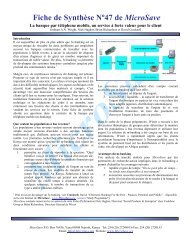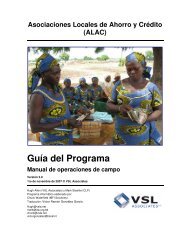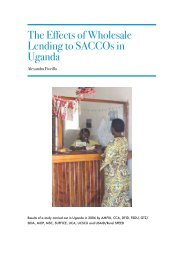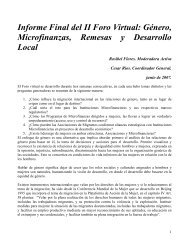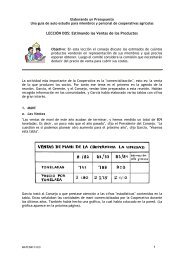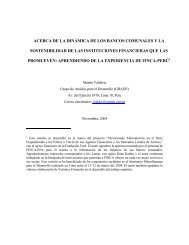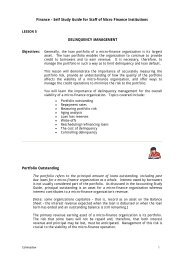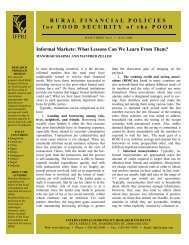review of warehouse receipt system and inventory credit initiatives in ...
review of warehouse receipt system and inventory credit initiatives in ...
review of warehouse receipt system and inventory credit initiatives in ...
Create successful ePaper yourself
Turn your PDF publications into a flip-book with our unique Google optimized e-Paper software.
negotiable <strong>warehouse</strong> <strong>receipt</strong> 4 , which can be used to raise f<strong>in</strong>ance or trade the commodity.<br />
Of at least equal significance were the steps taken by American monetary authorities, which<br />
eventually became the Federal Reserve Bank (created <strong>in</strong> 1913). These established a special<br />
discount w<strong>in</strong>dow for ‘eligible bankers’ acceptances’ backed by <strong>warehouse</strong> <strong>receipt</strong>s, mak<strong>in</strong>g<br />
them a very liquid <strong>in</strong>strument (see Box 1).<br />
BOX 1: THE FED’S DISCOUNT WINDOW FOR ELIGIBLE BANKERS’<br />
ACCEPTANCES<br />
(contribution by Nick Budd, retired lawyer specialised <strong>in</strong> commodity f<strong>in</strong>anc<strong>in</strong>g)<br />
The Federal Reserve Bank (‘the Fed’) announced that it would rediscount, at very f<strong>in</strong>e rates (the rate also<br />
serv<strong>in</strong>g as an important <strong>in</strong>strument <strong>of</strong> monetary policy) bankers’ acceptances issued by US banks (no matter<br />
how small <strong>and</strong> rural) so long as they were "eligible." To qualify, they had to: (a) be <strong>of</strong> limited duration (270<br />
days or less), (b) have a maturity approximat<strong>in</strong>g the normal period <strong>of</strong> liquidation <strong>of</strong> the underly<strong>in</strong>g asset (i.e.<br />
match the anticipated storage <strong>and</strong> resale period), (c) be backed by a <strong>warehouse</strong> <strong>receipt</strong> (negotiable or nonnegotiable)<br />
issued to the bank (but only at the time <strong>of</strong> acceptance), (d) cover regularly marketable staple<br />
commodities (to <strong>in</strong>sure some k<strong>in</strong>d <strong>of</strong> market valuation <strong>and</strong> liquidity), <strong>and</strong> (e) be <strong>in</strong>sured aga<strong>in</strong>st fire, theft, flood,<br />
etc. The small rural banker would gather up these documents, get the farmer to sign a draft payable <strong>in</strong>, say, 270<br />
days, write "accepted" on the back, <strong>and</strong> send it to a money center bank, which would discount it <strong>and</strong> send the<br />
funds to the local bank which would use the funds to discount the farmer's draft. When the goods were sold, the<br />
farmer repaid the local bank, <strong>and</strong> the local bank repaid the money center bank.<br />
The money center bank could do this because it was able at any time to sell (rediscount) these drafts at any time<br />
with the Fed at very f<strong>in</strong>e rates, without limitation, or to sell them <strong>in</strong>to the active money market to short term<br />
<strong>in</strong>vestors. In addition, the Fed <strong>of</strong>fered the further <strong>in</strong>ducement that banks creat<strong>in</strong>g or discount<strong>in</strong>g eligible<br />
banker's acceptances were exempt from the usual reserve requirements attached to such liabilities (<strong>in</strong> those days,<br />
up to 20%), <strong>and</strong> were also exempt from regulations limit<strong>in</strong>g loans based upon capital <strong>and</strong> per-customer<br />
limitations. Federal regulations also authorized banks to accept field <strong>warehouse</strong> 5 <strong>receipt</strong>s as security for eligible<br />
acceptances where local (State) law recognized the validity <strong>of</strong> these <strong>receipt</strong>s. By 1900 there were over 200<br />
field warehous<strong>in</strong>g companies <strong>and</strong> many thous<strong>and</strong>s <strong>of</strong> separate field <strong>warehouse</strong>s. This <strong>in</strong> turn <strong>in</strong>duced farmers<br />
<strong>and</strong> merchants to <strong>in</strong>vest <strong>in</strong> local storage without the need to become licensed <strong>warehouse</strong>men.<br />
The eligible bankers’ acceptance market, based largely upon rural <strong>warehouse</strong> <strong>receipt</strong>s <strong>and</strong> drafts signed by small<br />
farmers, rapidly became the key short term f<strong>in</strong>anc<strong>in</strong>g mechanism <strong>in</strong> the United States <strong>and</strong> <strong>of</strong>fered a direct cash<br />
pipel<strong>in</strong>e from the money centers to the smallest local banks. One could argue that this ref<strong>in</strong>anc<strong>in</strong>g facility<br />
provided the oxygen which fuelled the rapid creation <strong>of</strong> agricultural <strong>credit</strong>, <strong>warehouse</strong> development, market<strong>in</strong>g<br />
<strong>system</strong>s, transport <strong>system</strong>s, <strong>in</strong>surance products, <strong>and</strong> <strong>warehouse</strong> law reform <strong>in</strong> the United States.<br />
Licensed <strong>warehouse</strong>s have to meet <strong>and</strong> ma<strong>in</strong>ta<strong>in</strong> key criteria <strong>in</strong> terms <strong>of</strong> physical facilities,<br />
capital adequacy, liquidity, managerial qualities, <strong>in</strong>surance <strong>and</strong> bond<strong>in</strong>g cover (the latter<br />
protects depositors aga<strong>in</strong>st fraud <strong>and</strong> mismanagement). Some States have set up Indemnity<br />
Funds to which licensed <strong>warehouse</strong> operators must contribute, <strong>and</strong> this takes the place <strong>of</strong> the<br />
bond. Gra<strong>in</strong> h<strong>and</strong>l<strong>in</strong>g staff at the <strong>warehouse</strong>s (weighers, samplers <strong>and</strong> graders) must also be<br />
licensed to carry on their activities, <strong>and</strong> commodities are graded to US st<strong>and</strong>ards.<br />
Warehouses are subject to unannounced visits by ‘exam<strong>in</strong>ers’ who are responsible for<br />
enforc<strong>in</strong>g the law <strong>and</strong> who can literally suspend or revoke a <strong>warehouse</strong> license overnight. The<br />
4<br />
As <strong>of</strong> 1998, there were almost 12,000 elevators <strong>in</strong> the US with a fixed storage capacity <strong>of</strong> 230 million tonnes;<br />
cooperatives owned about one third <strong>of</strong> them.<br />
5<br />
A warehous<strong>in</strong>g service provided <strong>in</strong> the clients’ premises, normally to enable the client to obta<strong>in</strong> f<strong>in</strong>anc<strong>in</strong>g<br />
aga<strong>in</strong>st stock held there<br />
12




